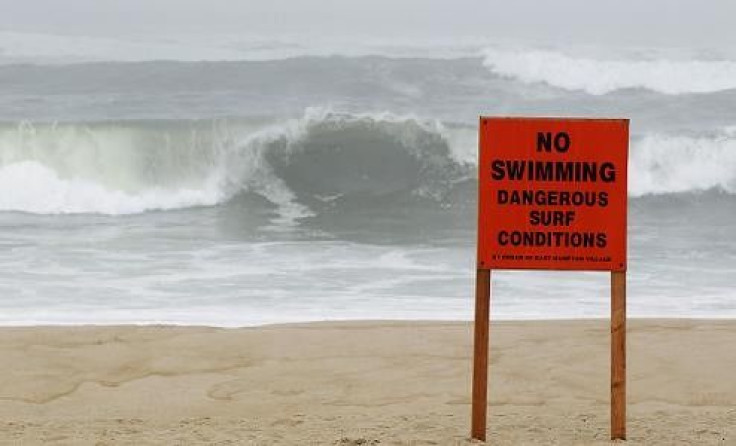Hurricane Irene Connecticut: State of Emergency Declared as Storm Approaches

State officials and residents of Connecticut braced for the worst from Hurricane Irene Saturday at mid-day, while also hopeful that the storm, which had weakened slightly to a Category 1 hurricane as it lashed the coasts of South Carolina, North Carolina, and Virginia, would not re-strengthen as it begins what forecasters expect to be a damaging path up the East Coast.
Even so, residents in flood-prone areas should evacuate now, Gov. Daniel Malloy said, and no one should underestimate the human and property casualties this storm can trigger: even a Category 1 storm can pack winds up to 75 miles per hour with heavy, flooding rains.
President Barack Obama, who cut short his summer vacation to return to Washington, on Saturday ordered federal aid to supplement Connecticut state and local response aid, effective immediately.
The NOAA/National Weather Service's hurricane warning remained in effect Saturday morning for Fairfield, Middlesex, New Haven and New London counties. The National Weather Service has also issued a tropical storm warning for Hartford, Tolland, Litchfield and Windham counties as well as a flood watch for Litchfield, Hartford, Tolland, Windham, Fairfield, Middlesex, New Haven and New London counties.
The last time a hurricane warning was issued for Connecticut was in September 1985 for Hurricane Gloria.
Hurricane Irene: Connecticut's Most Dangerous Storm Since 1985
Concerning Irene's position, as of 11 a.m. EDT, Irene, a Category 1 hurricane, was straddling the South Carolina / North Carolina border with winds up to 85 miles per hour (mph), moving north/north east at about 15 miles per hour.
Irene did make land-fall in the Carolinas, but meteorologists say that can be deceptive: hurricanes frequently touch land, then skirt the coast, before moving back out on to the sea, where they re-strengthen. In other words, Irene could re-strengthen in the day ahead -- creating even more damaging winds, storm surge. and rain.
Further, the latest forecast shows Hurricane Irene making, essentially, a direct hit on Connecticut by Sunday at 1 p.m. EDT after crossing the New York City metropolitan area.
Showers and wind should intensify throughout the Saturday, Fox CT Chief Meteorologist Joe Furey said, The Hartford Courant reported Saturday.
By Saturday night, Furey said, rainfall will become steady and get heavier with wind gusts reaching between 55 and 75 mph.
We are going to get pounded hard tomorrow, Furey said.
Rainfall estimates vary, but if Category 1 case history is any indicator, Connecticut could receive 4 to 7 inches of rain, with local amounts up to 10 inches, by the time Irene leaves the state on Monday
In Hartford, Gov. Dannel P. Malloy urged residents in low-lying areas to evacuate for higher ground by mid-Saturday as Irene moved up the East Coast, newstimes.com reported Saturday. If residents of flood-prone areas wait, it will be much harder for emergency personnel to rescue them -- something that will substantially increase the risk to life and result in more injuries.
Malloy said the biggest concern with Irene is flooding along Long Island Sound. The storm, coupled with high tide, may cause a water surge one or two feet higher than the perfect storm surge Connecticut experienced in 1992, The New Haven Register reported Saturday. Malloy planned to talk with representatives from shoreline communities from East Haven to Greenwich to see that any necessary evacuations are under way.
Malloy also urged all residents to complete all travel by sundown Saturday. Be off the road by the time the sun goes down, Malloy said, The Register reported.
Utility: You May Lose Power for A Long Time
Also, The Connecticut Light & Power Co. issued a warning/advisory to customers: if you lose power, you could be without electricity for a week or more, The Courant reported Saturday.
Gov. Malloy also said state officials are concerned that the Merritt Parkway/Wilbur Cross Parkway will see many downed trees -- the parkway is lined with trees and growth -- and the road has many low areas that can flood.
Public transportation in and out of Connecticut will be suspended starting Saturday afternoon. CT Transit bus and paratransit operations will be suspended in the Hartford, New Haven, Stamford, Bristol, New Britain, Meriden, Waterbury, and Wallingford, areas beginning at 8 p.m. Shoreline East rail service will also stop.
At the University of Connecticut in Storrs, the administration canceled the first of classes for Monday Aug. 29, UConn said, in a statement. Students are strongly discouraged from returning to campus on Sunday, Aug. 28, due to likely severe weather conditions.
The last major hurricane to cross the state was Hurricane Gloria in September 1985, with the storm crossing Long Island, N.Y. and making landfall in Fairfield County, Conn. Overall, along the East Coast, Gloria killed eight people and caused about $900 million in damages, or about $1.84 billion in 2011 dollars.
Connecticut's ground is already saturated from previous rain storms, therefore any additional rain will mostly runoff, swelling rivers and soaking low-lying areas. That saturated ground plus high winds will likely bring down sensitive and/or weaker trees, officials say, and could also result in extensive power outages.
See Also: Hurricane Irene 2011 - 12 Survival Tips
© Copyright IBTimes 2024. All rights reserved.











